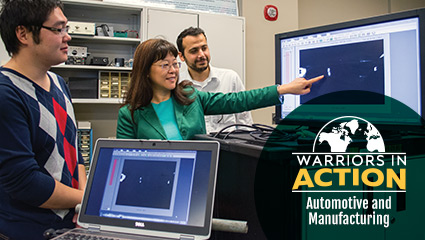Over the coming months, look for stories that feature some of the many Wayne State initiatives and pioneering individuals committed to automotive and manufacturing innovation. This content is part of WSU's Warriors in Action campaign highlighting how Wayne State is making a difference.
 Companies within the vast manufacturing industry continue to assess the quality and capability of nondestructive evaluation (NDE) technology for a number of reasons, including but not limited to safety, reliability and cost effectiveness. Professor Xiaoyan Han’s research aims to address all of those factors and more.
Companies within the vast manufacturing industry continue to assess the quality and capability of nondestructive evaluation (NDE) technology for a number of reasons, including but not limited to safety, reliability and cost effectiveness. Professor Xiaoyan Han’s research aims to address all of those factors and more.
Han, a professor of electrical and computer engineering at Wayne State, has developed an NDE method called Sonic Infrared (Sonic IR) imaging. Using this method, defects in materials can be detected by injecting ultrasound into an object to produce localized frictional heating at any defects that may be present, including cracks, delaminations and disbonds. Sonic IR can detect cracks as small as one thousandth of an inch, and Han notes that a number of innovations are being made with this technology.
“For metal materials, it could take only a second or even a fraction of a second to detect defects,” said Han. “It is not only fast, but the technology can image a wide area in each snapshot.”
The dark-field imaging is another feature of this technique, in which only defects light up against a dark background, greatly increasing the detectability of deficiencies in materials. Sonic IR can also detect cracks from any angle — a limitation in previous techniques.
Sonic IR technology involves transmitting a short ultrasonic pulse into an object, and heat from friction in cracks or defects is localized. The thermal radiation is detected by a sensor or camera, allowing technicians to pinpoint defects that otherwise may have gone unnoticed.
The Federal Aviation Administration and aircraft manufacturers are among the various groups looking at this technology as a means to lower production costs, avoid liabilities and recalls, build a competitive advantage, or grow their workforce. Siemens Power Generation Inc., which named its version of Sonic IR SIEMAT (Siemens Acoustic Thermography), has licensed the technology exclusively for land-based power turbine applications for years, creating a significant revenue stream for Wayne State University in the process.
Since Han and fellow WSU faculty members Skip Favro and Robert Thomas began working on Sonic IR over 15 years ago, the technology has received widespread acclaim. It was featured in the 2006 publication Technology Transfer Stories: 25 Innovations That Changed the World as part of the Better World Project, an initiative launched by the Association of University Technology Managers.
Han concludes that Sonic Infrared imaging will allow for more advanced evaluation and inspection processes, online testing and quality control to industries such as aerospace, automotive, power and energy, and civil engineering.